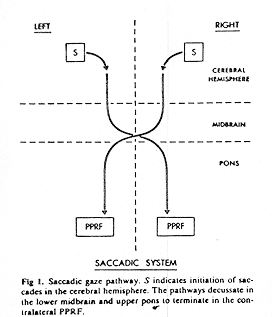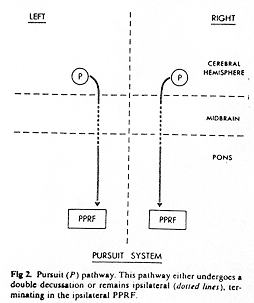| 1. Describe the supranuclear control of ocular movements | |||
| There are four separate subsystems of supranuclear ocular motor control,
each with different neurophysiologic characteristics and (largely) separate
neuroanatomic pathways.
The four subsystems are: (1) Saccadic or fast eye movement subsystems (1) Saccadic or fast eye movement subsystems The rapid versional (conjugate) eye movements are under both voluntary and reflex control. Examples of voluntary saccades are willed refixations and those in response to command, eg "Look to the right"; "Look up". The sudden appearance of a peripheral object or an eccentric sound may evoke a reflex saccade in the direction of the stimulus. In the usual situation these saccades are accompanied by head movements in the same direction. However, in both clinical examinations and most physiologic experiments, the head is stabilized. The visual stimulus for a saccade is target (object) displacement. Following an instantaneous change in target position, the human ocular motor system will respond with a saccade after a latency (delay) of 200 to 250 msec. Both the peak velocity and the duration of the saccade are dependent upon the size (amplitude) of eye movement, varying from 30 degrees to 700 degrees/second respectively, for movements from 0.5 degrees to 40 degrees in amplitude. Saccades are conjugate and ballistic. The physiological control system responsible for their generation is discrete, that is, at discrete instants in time, control decisions are made based upon the continuous inflow of visual information from the retina; these decisions are essentially irrevocable: once the eyes are in motion their trajectory cannot be altered. The control signal is retinal position error, which is reduced to zero by the negative feedback nature of this subsystem. After an appropriate latency, the saccadic response to target displacement
consists of a period of acceleration to peak velocity and deceleration
of the eyes onto the new target position. The muscular activity in the
agonist-antagonist pair is characterized by a burst of maximal facilitation
in the agonist, and total inhibition in the antagonist during the movement
deceleration is not consequent to active braking by the antagonist muscle.
Rather, the two muscles merely assume the relative tensions necessary to
hold the new target position. This is sufficient to accomplish the rapid
deceleration because of the braking effect (damping) of the "ocular motor
plant" (ie, globe, muscles, check ligaments, and fatty supporting tissues
of the orbit).
(2) Pursuit of tracking subsystem The major stimulus for a pursuit eye movement is a fixated target which
moves; this evokes a following eye movement after latency of 125 msec.
The maximum pursuit velocities are only 30 degrees to 50 degrees per second.
Pursuit eye movements are conjugate, smooth and under control system capable
of continuous modification of motor output in response to visual input
(in contrast to discrete saccadic control). The input signal is retinal
error ("slip") velocity which is reduced to zero when eye velocity matches
target velocity. Recent work suggests that the velocity of the target moving
across the retina is used by the brain to create an internal cerebral target
velocity signal and it is this "perceived target velocity" which drives
the pursuit system. This would provide an explanation for many of the "pursuit"
eye movement responses to non-moving targets such as after images. Under
most conditions a moving target is required to move the eyes smoothly;
attempts to voluntarily move the eyes smoothly without actual target motion
result in a series of small saccades, so called "cog-wheel" pursuit.
(3) Vergence subsystem The stimuli for vergence eye movements are target displacement or motion
along the visual z-axis (toward or away from the observer). The latency
for vergence eye movements is approximately 160 msec; maximum velocities
are in the range of 20 degrees per second, and the movements are generally
faster than divergence movements and the system is unique in being able
to generate uniocular eye movements. For example, if a target were placed
exactly in front of the right eye and slowly brought closer to the observer,
the right eye would remain stationary but the left eye would converge.
(4) Vestibular subsystem. Head movement is the stimulus for the compensatory eye movements elicited
by the vestibular system. The latency between the onset of head movement
and the resultant slow vestibular movement has been reported to vary from
10 to 100 msec. The peak velocities of vestibular induced eye movements
is also variable and may be as fast as 300 degrees. The eyes move in an
opposite direction in the head in response to head movements in the dark.
With a visible target the ocular counter-rotation may exactly match or
compensate the head movement.
In vestibulo-ocular subsystem of eye movement control the control signal
which produces the slow vestibular eye movement is head acceleration. The
signal is transduced by the semicircular canals to a neural signal proportional
to head velocity which is converted in the brainstem to a signal proportional
to position for the ocular motor neurons.
|

